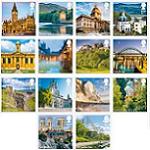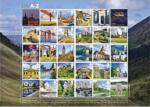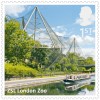
2012 Stamp Issues
5th Jan 2012 - Olympics and Paralympics Stamp Booklet
Tues 10th Jan 2012 - Roald Dahl
20th January 2012, year of the Dragon, Smilers Sheet.
Thurs 2nd Feb 2012- The House of Windsor
6th February - Diamond Jubilee
Thurs 23rd Feb 2012 - Britons of Distinction
Thurs 8th March 2012 - Classic Locomotives of Scotland
Tuesday 20th March 2012 - Comics
Tuesday 10th April 2012 - UK A-Z Part 2
Tues 15th May 2012 - Great British Fashion
Thurs 31st May 2012 - The Diamond Jubilee
Tues 19th June 2012 - Charles Dickens
Tues 27th July 2012 - Olympic Games Welcome
Wed 29th August 2012 - Paralympic Games Welcome
Thurs 27th Sept 2012 - Olympic & Paralympic Games Memories
Tues 16th Oct 2012 - Dinosaurs
Tues 30th Oct 2012 - Space Science
Tues 6th Nov 2012 - Christmas
UK A-Z Part 2
Issue Date 2012-04-10
The United Kingdom offers a host of iconic sights and memorable views. So in 2011 Royal Mail began a journey
of rediscovery, in alphabetical order, around the most important sights to be found on this sceptred isle.
This enabled Royal Mail to create the first part of this lovely issue, which took us from ‘A’ for Angel of the North
all the way to ‘L’ for Lindisfarne Priory.
The second part of the issue takes us from ‘M’ for Manchester
Town Hall right through to ‘Z’ for the ZSL London Zoo. Importantly, our featured landmarks were chosen to
represent every corner of the UK and to reflect many facets of our culture and history: with defence of the
realm represented by castles and code-breaking, and engineering acumen illustrated by sights such as the Forth and Tyne bridges.
Yet while these iconic places were all chosen for worthy reasons, each one also offers an aesthetic appeal that makes our UK A–Z as beautiful as it is informative, and a wonderful keepsake for every visitor to our island home in this very special year..
Issue Products
Stamp SetThe Royal Mail stamp policy team extensively researched UK gazetteers and drew up the list of potential subjects. Using a mix of commissioned and library photography the final line up was assembled and agreed considering the need to represent each of the four countries of the UK. The A - L stamps are issued in two sheets of 30 stamps featuring six se-tenant stamps in each row. The M - Z Stamps are printed across three sheets of 30 stamps, with M to R and S to X in se-tenant sheets of six stamps, with Y and Z on a strip of 6 (3 x Yand 3 x Z). |
|
A-Z Stamps SheetThe ideal way to enjoy all 26 Special Stamps in one spectacular sheet, which is made even more collectable by the addition of four special labels that take the number of iconic images up to 30. |
|
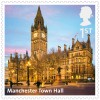 |
1st Class - Manchester Town HallOne of Britain’s greatest municipal buildings, Manchester Town Hall is a Victorian-era, neo-gothic design. The building functions as the ceremonial headquarters of Manchester City Council and houses a number of local government departments. |
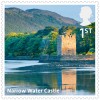 |
1st Class – Narrow Water CastleNarrow Water Castle is a famous tower house near Warrenpoint in Northern Ireland, located on the County Down bank of the Clanrye River, which enters Carlingford Lough a mile to the south. Narrow Water Castle was given into state care in 1956 and is one of the finest 16th-century buildings in Ireland. Narrow Water Castle tower house and bawn is a state care historic monument in the townland of Narrow Water, in Newry and Mourne District Council district.
Built for military purposes during the 1560s, Narrow Water Castle is a typical example of the tower houses erected throughout Ireland from the 14th until the early 17th century. This form of building, normally rectangular in plan and three or more storeys high, comprised a series of superimposed chambers, with stairs, closets and latrines skilfully contrived within the walls (which are 1.5metres or five feet thick in places) or sometimes contained in projecting angle turrets.
|
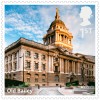 |
1st Class – Old BaileyThe Central Criminal Court in England, commonly known as the Old Bailey from the street in which it stands, is a court building in central London. he present building dates from 1902, but it was officially opened on 27 February 1907. It was designed by E. W. Mountford and built on the site of the infamous Newgate Prison, which was demolished to allow the court buildings to be constructed. Above the main entrance is inscribed the admonition, "Defend the Children of the Poor & Punish the Wrongdoer". King Edward VII opened the courthouse.
|
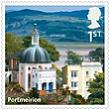 |
1st Class – PortmeirionPortmeirionis a popular tourist village in Gwynedd, North Wales. It was designed and built by Sir Clough Williams-Ellis between 1925 and 1975 in the style of an Italian village. It is one of Wales' most popular visitor attractions, with over 250,000 visitors every year. Portmeirion is now owned by a charitable trust, and has always been run as a hotel, which uses the majority of the buildings as hotel rooms or self-catering cottages, together with shops, a cafe, tearoom, and restaurant. Portmeirion has served as the location for numerous films and television shows, most famously serving as The Village in the 1960s television show The Prisoner. "PortmeiriCon" is the name given to ‘Six of One's’ regular Prisoner Conventions in the hotel village of Portmeirion. The society has held these events annually since 1977.
|
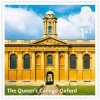 |
1st Class – The Queen's College OxfordThe Queen's College, founded 1341, is one of the constituent colleges of the University of Oxford. Queen's is centrally situated on the High Street, and is renowned for its 18th-century architecture. |
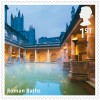 |
1st Class – Roman BathsThe Roman Baths complex is a site of historical interest in the city of Bath. The house is a well-preserved Roman site for public bathing. The Roman Baths themselves are below the modern street level. There are four main features: the Sacred Spring, the Roman Temple, the Roman Bath House and the Museum holding finds from Roman Bath. The buildings above street level date from the 19th century. The Baths are a major tourist attraction and, together with the Grand Pump Room, receive more than one million visitors a year. Visitors can see the Baths and Museum but cannot enter the water.
|
 |
1st Class – Stirling CastleStirling Castle, located in Stirling, is one of the largest and most important castles, both historically and architecturally, in Scotland. The castle sits atop Castle Hill, an intrusive crag, which forms part of the Stirling Sill geological formation. It is surrounded on three sides by steep cliffs, giving it a strong defensive position. Its strategic location, guarding what was, until the 1890s, the farthest downstream crossing of the River Forth, has made it an important fortification from the earliest times. Most of the principal buildings of the castle date from the fifteenth and sixteenth centuries. A few structures of the fourteenth century remain, while the outer defences fronting the town date from the early eighteenth century. Several Scottish Kings and Queens have been crowned at Stirling, including Mary, Queen of Scots, in 1543. There have been at least eight sieges of Stirling Castle, including several during the Wars of Scottish Independence, with the last being in 1746, when Bonnie Prince Charlie unsuccessfully tried to take the castle. Stirling Castle is a Scheduled Ancient Monument, and is now a tourist attraction managed by Historic Scotland.
|
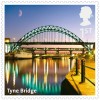 |
1st Class – Tyne BridgeThe Tyne Bridge is a through arch bridge over the River Tyne in North East England, linking Newcastle upon Tyne and Gateshead. The bridge was designed by engineering firm Mott, Hay and Anderson, who later designed the Forth Road Bridge, and it was built by Dorma Long & Co. of Middlesbrough. At the time of its construction it was the world's longest single span bridge. The bridge was officially opened on 10 October 1928 by King George V and has since become a defining symbol of Tyneside. It currently stands as the tenth tallest structure in the city.
|
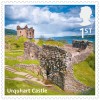 |
1st Class – Urquhart CastleUrquhart Castle sits beside Loch Ness in Scotland along the A82 road, between Fort William and Inverness. It is close to the village of Drumnadrochit. Though extensively ruined, it was in its day one of the largest strongholds of medieval Scotland, and remains an impressive structure, splendidly situated on a headland overlooking the Loch. It is also near this castle that the majority of Loch Ness Monster sightings occur. |
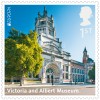 |
1st Class – Victoria and Albert MuseumThe Victoria and Albert Museum (often abbreviated as the V&A), set in the Brompton district of The Royal Borough of Kensington and Chelsea, London, is the world's largest museum of decorative arts and design, housing a permanent collection of over 4.5 million objects. Named after Prince Albert and Queen Victoria, it was founded in 1852, and has since grown to cover 12.5 acres (51,000 m2) and 145 galleries. The laying of the foundation stone to the left of the main entrance of the Aston Webb building, on 17 May 1899, was the last official public appearance by Queen Victoria. It was during this ceremony that the change of name from the South Kensington Museum to the Victoria and Albert Museum was made public. |
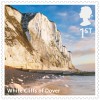 |
1st Class – White Cliffs of DoverThe White Cliffs of Dover are part of the North Downs formation. The cliff face, which reaches up to 107 metres (351 ft), owes its striking façade to its composition of chalk accentuated by streaks of black flint. The cliffs spread east and west from the town of Dover in the county of Kent, an ancient and still important English port. The cliffs have great symbolic value for Britain because they face towards Continental Europe across the narrowest part of the English Channel, where invasions have historically threatened and against which the cliffs form a symbolic guard. Because crossing at Dover was the primary route to the continent before air travel, the white line of cliffs also formed the first or last sight of the UK for travellers. |
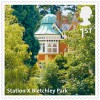 |
1st Class – Station X Bletchley ParkStation X, a radio intercept station, is located in Bletchley Park,an estate located in the town of Bletchley, in Buckinghamshire, where during World War II, 12,000 people worked in total secrecy. BletchleyPark was the site of the United Kingdom's main decryption establishment, the Government Code and Cypher School (GC&CS), where ciphers and codes of several Axis countries were decrypted, most importantly the ciphers generated by the German Enigma and Lorenz machines. |
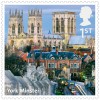 |
1st Class – York MinsterYork Minsteris one of the largest Gothic cathedrals in Northern Europe. It is the seat of the Archbishop of York, the second-highest office of the Church of England, and cathedral for the Diocese of York. The governing body of York Minister is the Chapter headed by the Dean of York. Its formal title is The Cathedral and Metropolitical Church of St Peter in York. The title "Minster" is attributed to churches established in the Anglo-Saxon period as missionary teaching churches. It has a very wide Decorated Gothic nave and chapter house, a Perpendicular Gothic choir and east end and Early English north and south transepts. The nave contains the West Window, constructed in 1338, and over the Lady Chapel in the east end is the Great East Window (finished in 1408), the largest expanse of medieval stained glass in the world. In the north transept is the Five Sisters Window, each lancet being over 16 metres (52 ft) high. The south transept contains a famous rose window. |
1st Class – ZSL London ZooZSL London Zoo is the world's oldest scientific zoo It was opened in London on 27 April 1828, and was originally intended to be used as a collection for scientific study. It was eventually opened to the public in 1847. Today it houses a collection of 755 species of animals, with 16,802 individuals, making it one of the largest collections in the United Kingdom. |
Technical Details
| Feature | Type/Detail |
Number of stamps |
Fourteen |
| Design | Robert Maude and Sarah Davies |
| Acknowledgements | Manchester Town Hall, Stirling Castle, Urquhart Castle and York Minster photography © Joe Cornish; Narrow Water Castle, Portmeirion, Roman Baths, Victoria and Albert Museum and White Cliffs of Dover photography © David Noton; Old Bailey photography © Eric Nathan/Alamy; The Queen’s College Oxford and ZSL London Zoo photography © Charlie Waite; Tyne Bridge photography © Edmund Nagele/Alamy; Station X Bletchley Park photography © Rolph Gobits |
| Stamp Format | Square |
| Stamp Size | 35mm x 35mm |
| Printer | Cartor Security Printing |
| Print Process | Lithography |
| Number per Sheet | 30/60 |
| Perforations | 14.5 x 14.5 |
| Phosphor | All over |
| Gum | PVA |

designed by KMcS, Dec 2009
